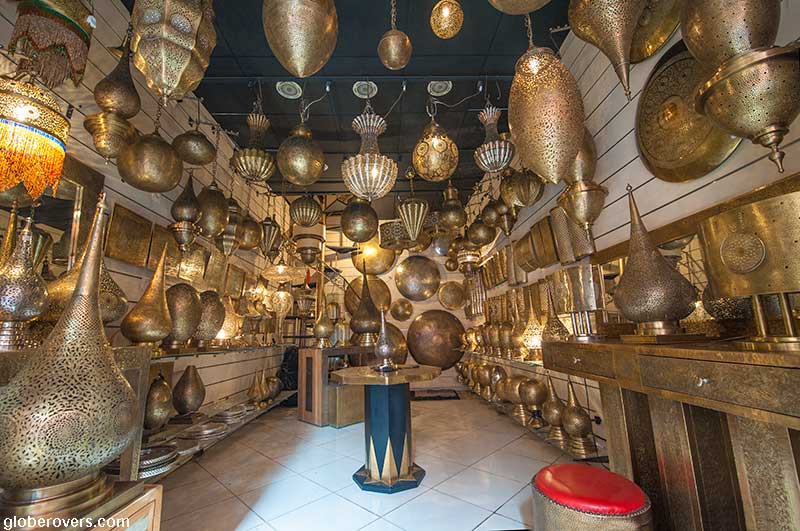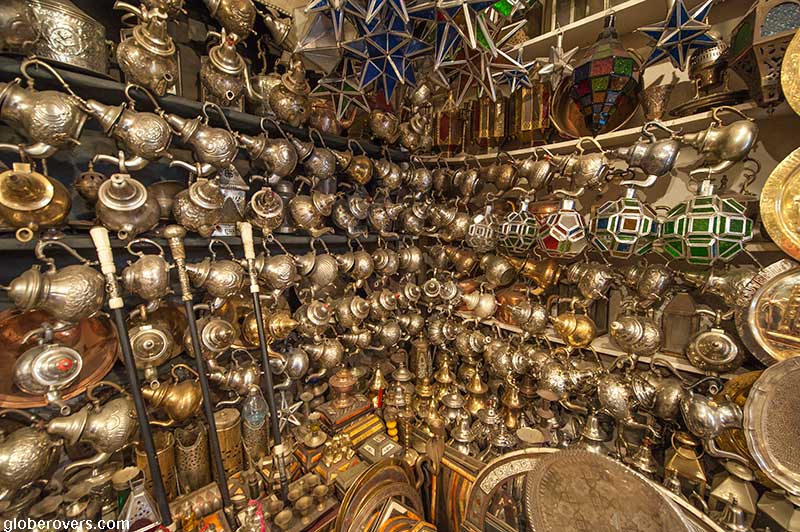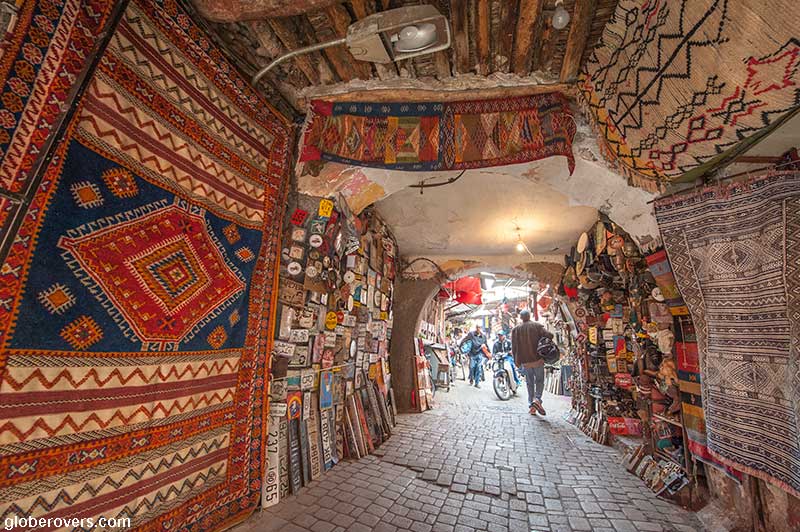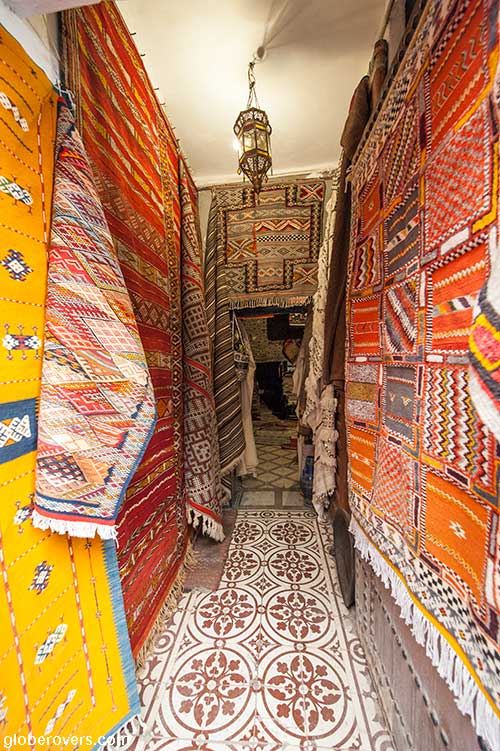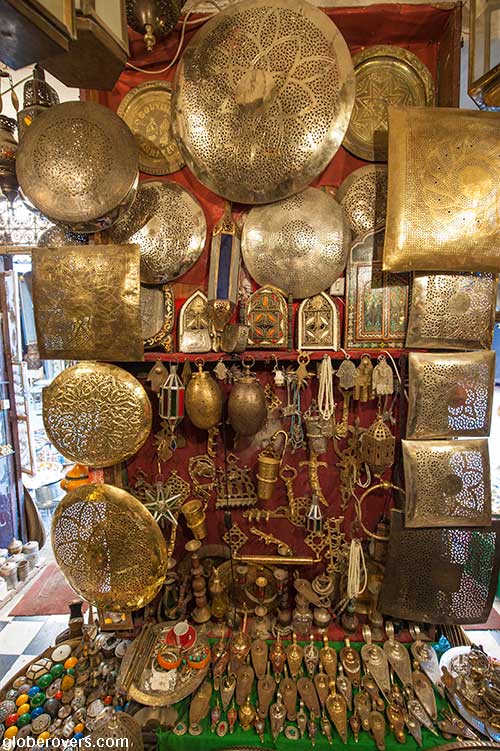
The fourth-largest city in the Morocco, after Casablanca, Fez and Tangier, Marrakech has no shortage of action, in particular its souks and the Jemaa el-Fnaa square which showcases entertainers in medieval dress, snake charmers, acrobats, magicians, mystics, musicians, monkey trainers, herb sellers, story-tellers, pickpockets, and the local mafia who ensures that all viewers hand over their tips!
Marrakech is most famous for its souks and central square
Why travel south of Marrakech to Fint Oasis?
- The low-down: After a few days in Marrakech, drive south the fortified village of Aït Benhaddou, and then continue south to Ouarzazate and further south to Fint Oasis. A very interesting ride!
- The brightest highlight: While Marrakech has become touristy with very annoying, pushy and rude “agents” on the streets, it is an interesting city if you can remain immune to these people who constantly target tourists to extort money.
- Intrepid destination: Most of this route is quite touristy, however, as soon as you drive away from the tour bus trail, you will be in a different world.
- Globerovers score (10 is highest): I was quite disappointed with Marrakech. The rest of this route, in particular the drive over the mountains to Aït Benhaddou and onwards to Fint Oasis was really interesting. I’ll score it 8.1 out of 10.
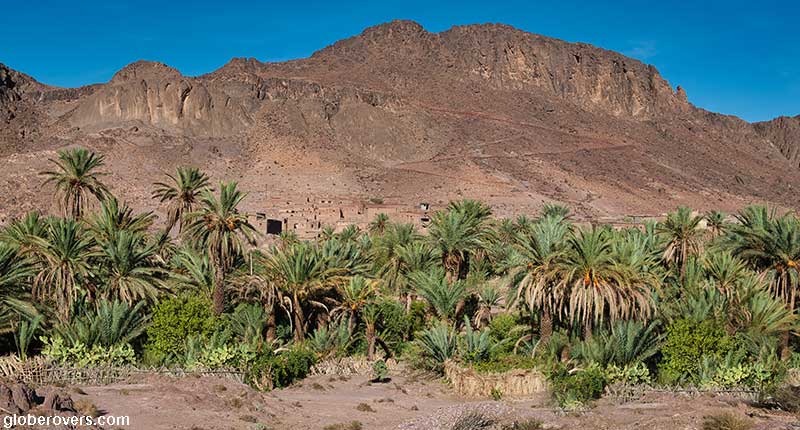
Table of Contents
Attractions of Marrakech
For most people, the name Marrakech brings up memories of popular movies. Think “The Mummy”, “Raiders of the Lost Ark”, “Prince of Persia”, and many more. These movies have unquestionably made Marrakech famous for its bustling copper and leather souks, its villains, snake charmers, street performances, mint-tea-sipping tourists, and many more.
Marrakech is one of those places you will either love or hate. Either way, you should explore everything this city has to offer and you could stay here for a few weeks!
It is hard to describe Marrakech. In fact, once you arrive in Marrakech you will be so overwhelmed that you will not know in which direction to go! But let’s go and walk in any direction, as you will swiftly get lost and that is perfectly fine. Fear not, as you will find yourself, and hopefully your hotel, by the end of the day.
The medina, the old walled part with its countless narrow and maze-like streets, is rather unnavigable. Try out your smartphone’s Google map as you get lost in the medina. While not perfectly accurate, it will give you a sense of where you are. Better yet, put away your digital map and just let the medina suck you in. There is no better feeling than to get lost in one of Morocco’s medinas such as in Marrakech or Fes. You will be amazed by most everything you will discover.
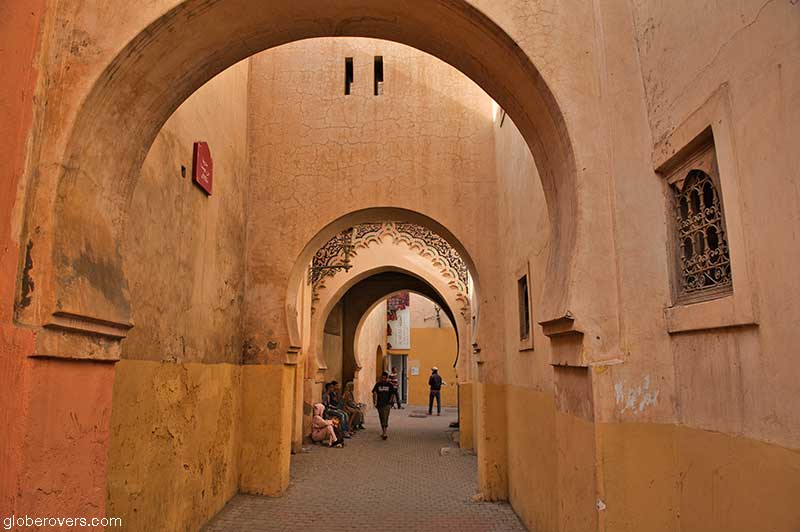
The attractions in Marrakech are numerous. For a culture shock, walk around the famous Djemaa El Fna central square. Here you will come face-to-face with musicians, storytellers, fortune-tellers and snake charmers. In fact, in the late afternoon and early evening, the entire spectrum of Moroccan life will unfold right in front of your eyes.

Watch out for the local mafia who ensures that all onlookers pay their dues of appreciation before leaving a performance, in particular those of the snake charmers, monkey handlers, and the African drum beaters. Don’t resist making a small payment as these people are ferocious.
Before long you will want to escape the madness of the square, so head out to one of the many rooftop cafes and restaurants from where you can safely survey the crazy scene from above.
Once you have conquered and tamed your fears about a night out on Djemaa El Fna square, head into Marrakech’s labyrinth medina. The ancient narrow alleyways of the medina are a spectacular kaleidoscope of colours, sounds, scents, and aromas which are enough to place all your senses into overdrive!
Check out the Babouche (shoe) Souk, the famous Chouari (carpenter’s) Souk, the El-Attarine (perfume and spice) Souk and make sure not to miss the Cherratine (leather) Souk.

Copper Souk, Marrakech 
Copper Souk, Marrakech 
Leather Souk, Marrakech 
Carpet Souk, Marrakech

Carpet Souk, Marrakech 
Copper Souk, Marrakech
To the northeast of the square follow your nose and you will find the Marrakech tanneries where animal skins are dyed the old-fashioned way. Around the tanneries are some very persistent leather salesmen disguised as tour guides, who will unfortunately become verbally abusive if you do not accept their “guiding services”. Don’t let their rude behaviour taint your impressions of the Moroccan people.
Other than the souks, the medina offers a wealth of interesting sights such as the Ben Youssef Madrasa built in 1565 by the Saadians. This Islamic college is named after the Almoravid sultan Ali ibn Yusuf who reigned between 1106 and 1142. The college closed down in 1960, but reopened to the public as a historical site in 1982.
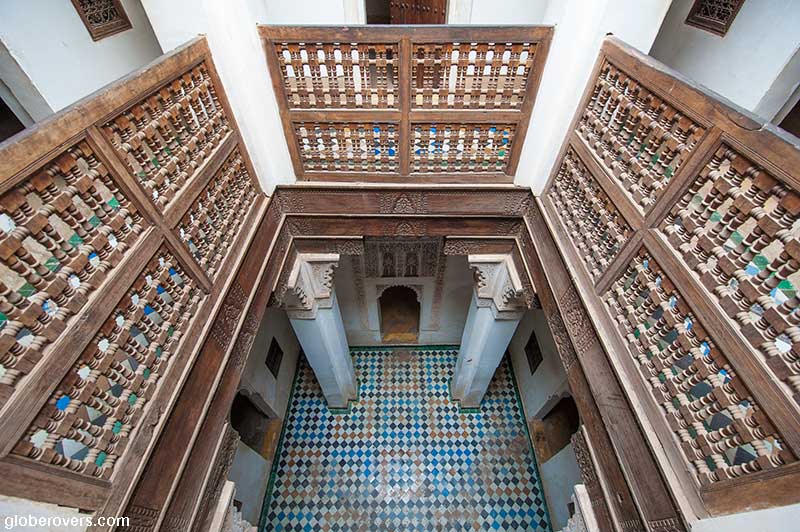
Other sites in and around Marrakech include the Koutoubia Mosque with its striking 70 m tall minaret towering over Djemaa El Fna central square, the 16th-century Saadian tombs and the 19th century Bahia Palace.
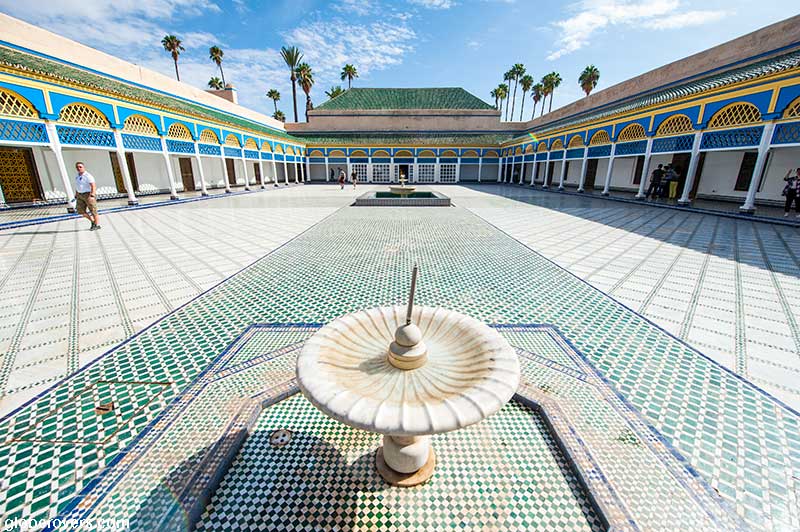
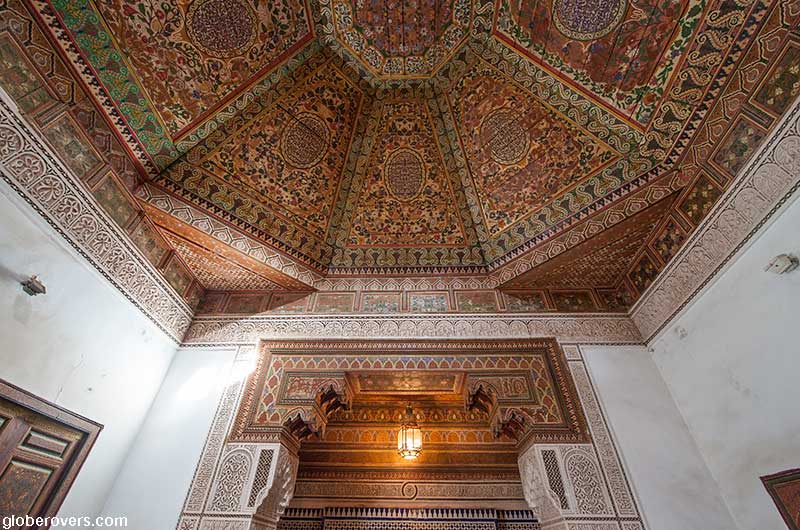
Not to be missed is the small Maison Tiskiwin house-museum. Here you can travel to Mali’s Timbuktu and back again with the help of Dutch anthropologist and professor of art history Bert Flint’s art collection. Each separate room in this Hispano-Moorish former residence of Bert’s represents a different caravan stop along the long Sahara-to-Marrakech route, showcasing Bert’s incredible collection of items which range from indigenous crafts of the Tuareg people, to carpets from the High Atlas.
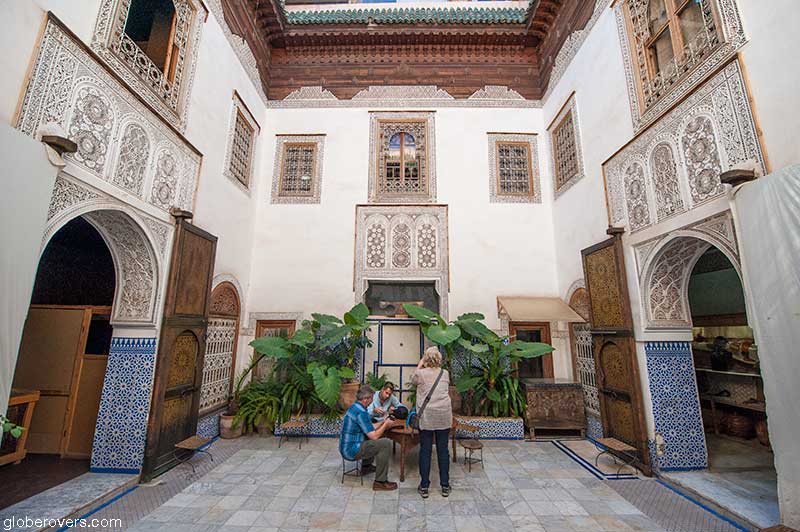
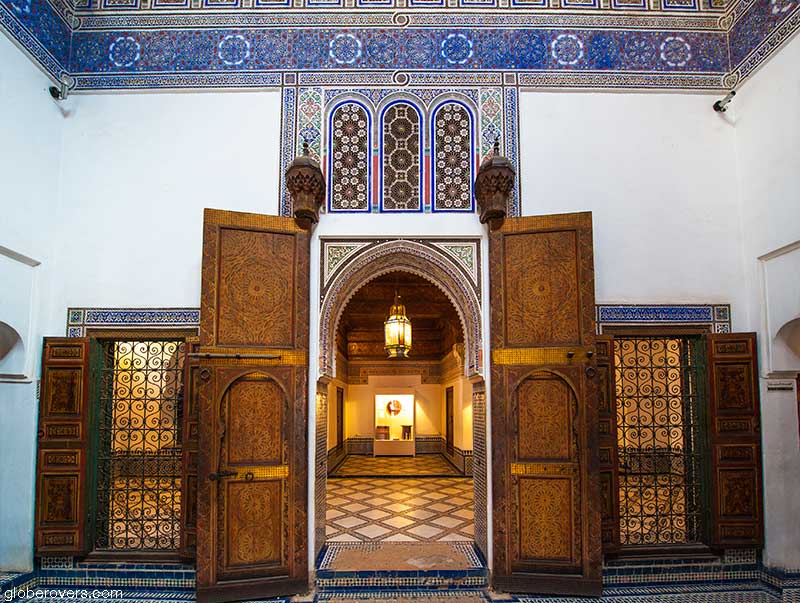
Accommodation in Marrakech ranges from luxury kasbahs and riads, to more affordable riads (houses with central gardens), dars (houses without central gardens), auberges, boutique hotels and guesthouses. Highly recommended is the Riad Le Bel Oranger located inside the medina. Contact them directly at riadlebeloranger@gmail.com to make a reservation, or book via your favourite hotel booking website.
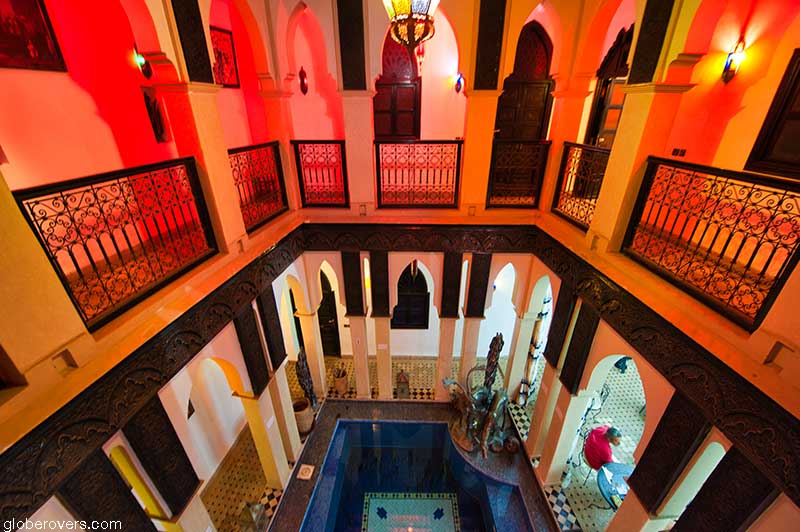
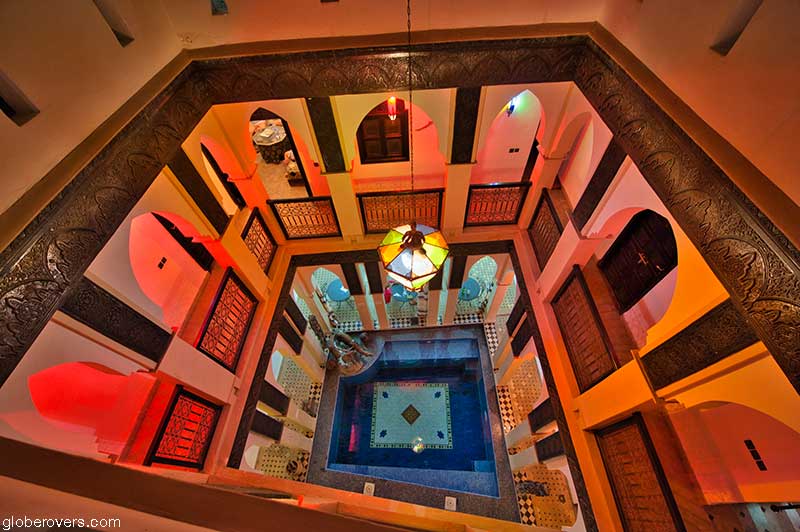
The Fortified Village of Aït Benhaddou
South of Marrakech in the southern foothills of the High Atlas, lies one of Morocco’s nine UNESCO World Heritage Sites. Welcome to the 17th-century Ksar of Aït-Benhaddou which has served as the locale for many films including Indiana Jones, Babel, Lawrence of Arabia, Jesus of Nazareth (for which much of Aït Benhaddou was rebuilt), Jewel of the Nile, and Gladiator.
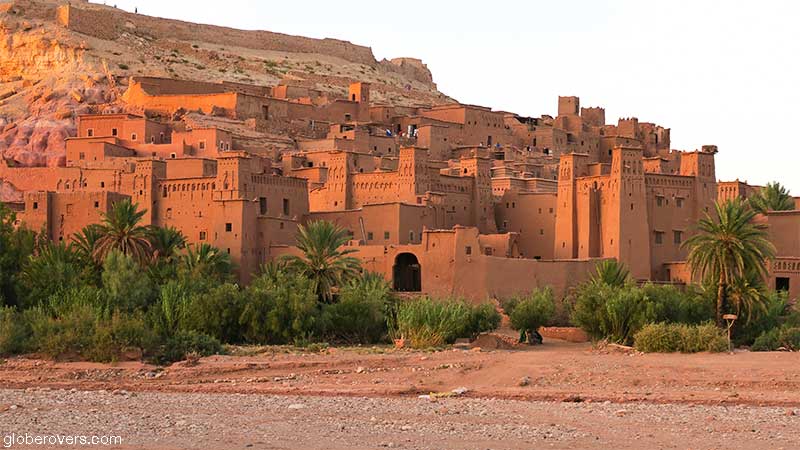
A “ksar” is a small collection of adobe buildings normally surrounded by high walls as is typical of a traditional Saharan community. The surrounding defensive walls are reinforced by corner towers which rise high above the walls. Aït-Benhaddou is a striking example of such architecture and built entirely of local organic material, which is covered by a rich red mud plaster from the nearby Ounila River.
A 17th-century fortified village complete with kasbahs
Made up of six kasbahs and almost 50 smaller ksour (plural for ksar), local belief is that the ksar was founded in 757 AD. by Ben-Haddou whose tomb is said to lie somewhere below the old city. However, the oldest structures of Ait-Benhaddou only date back to the early 17th century.
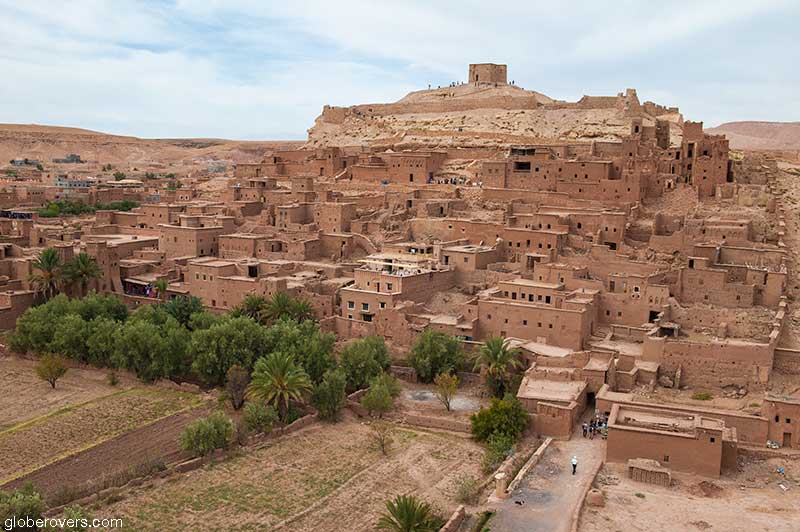
First constructed as an Almoravid caravanserai, it provided shelter to travellers along the trading routes which linked ancient Sudan to the souks of Morocco’s Marrakech. The traded goods must have included items such as gold, salt, and West African slaves that passed along this route since ancient times but reached a peak between the 8th century AD and the late 16th century AD. As these traders brought in such valuable items, the defensive walls were necessary to protect them and the kasbah residents from the bandits and raiding nomads.
As the trans-Saharan trade declined by the late 17th century, Ait-Benhaddou remained important as it transformed itself to be the centre of local power.

While many of the structures of Ait-Benhaddou are in a derelict state, some of the buildings remain occupied by resident families, who increasingly set up shop selling souvenirs to the tourists. Other than the living quarters, the ksar is home to a mosque, a public square, grain threshing areas outside the ramparts, a fortification at the top of the village (the agadir), a caravanserai, and two cemeteries (Muslim and Jewish).

The views of the surrounding arid stony desert are mesmerising as seen from the large fortified granary, or agadir, on the hill above the ksar. Watch as the colours change throughout the day.
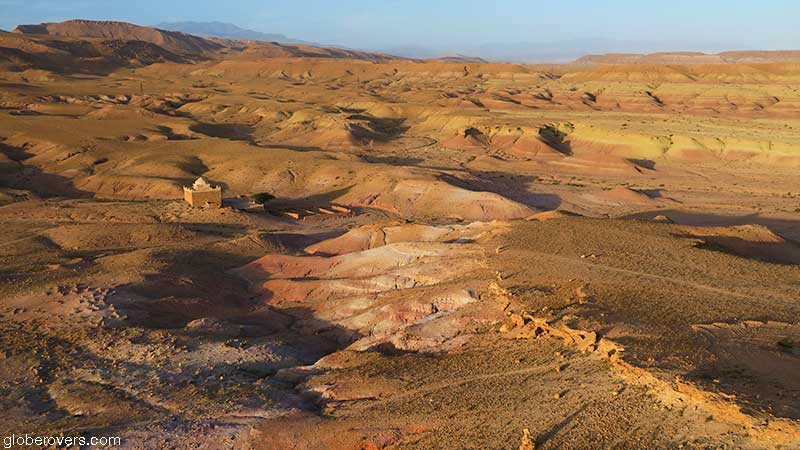
In the relatively more modern part of town, around the ksar of Ait-Benhaddou, live the rest of the local residents. Many are involved in the tourist trade offering souvenirs, restaurants, guesthouses, and anything that can earn money from the tourists. Most of the souvenirs on offer are actually more than just tourist junk. Look out for some good quality argan oil, beautiful ceramics, leather products, paintings of Ait-Benhaddou and its inhabitants, hammered metalworks, rugs and carpets, and of course, spices and dried fruits such as dates, figs, olives, walnuts, and almonds. All prices are negotiable, and friendly bargaining is expected and fun if you do it with the right mindset.
Along the small unpaved road north of Ait-Benhaddou are the interesting villages of Assfalou and Tamedakhte, boasting ancient and more modern kasbahs complete with camel rides!

Ouarzazate
The drive down south from Marrakech is beautiful as you follow the winding road through the High Atlas mountains.
About 30 km southeast of Aït Benhaddou lies the town of Ouarzazate, which can aptly be described as the “Door of the Desert” or “Gateway to the Sahara Desert”.
Ouarzazate is worth a night or two to see a few note-worthy tourist sites such as the Atlas film studios, the movie museum, and the main town square. You may also want to stay in town to have a full day visit to a few surrounding attractions such as Fint Oasis.
In Ouarzazate stay at the beautiful and charming Dar Rita Guesthouse.
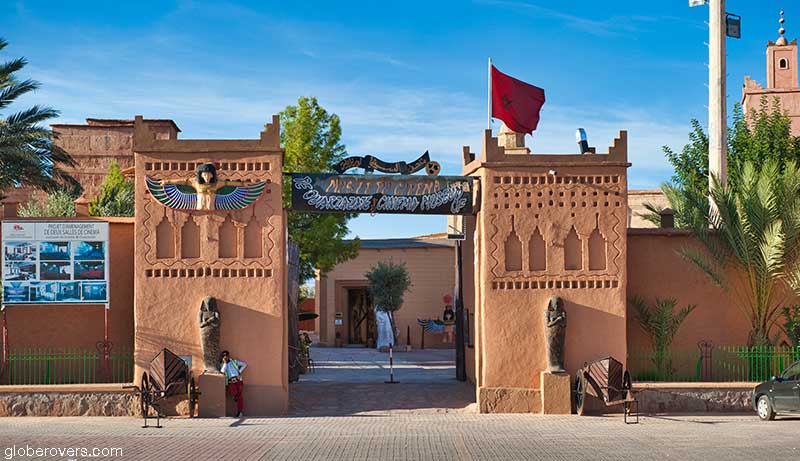

Fint Oasis
Less than 20 km south of Ouarzazate is the lush palm garden village of “Oasis de Fint”. The rough unpaved road leading from Ouarzazate to Fint Oasis is barren and desolate, typical terrain of the Small Atlas Mountains. From a distance, the verdant date palm groves around the oasis are clearly visible.
Fint Oasis served as the setting for several Hollywood films
If you have always wanted to visit an authentic oasis community, this is the place to be. Life here is very laid back. Pack donkeys still roam the streets and women wash the family’s clothes in the small stream. People are reserved which is likely due to language barriers. If you speak a little French, the conversations over a mint tea will be easier.
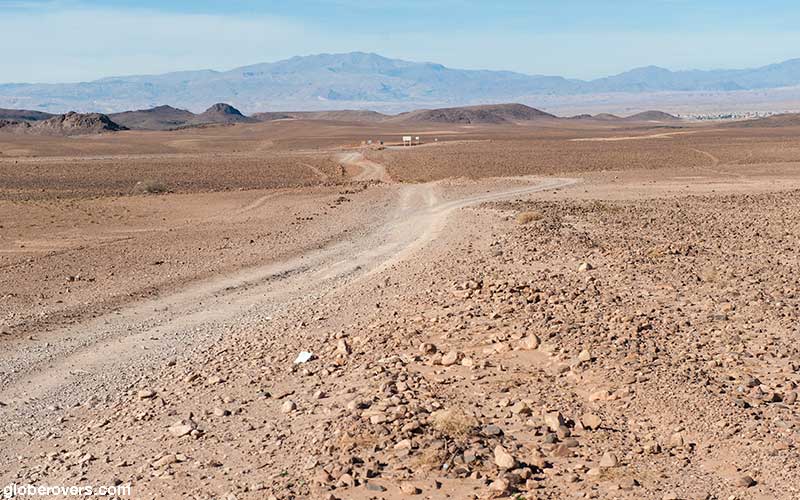
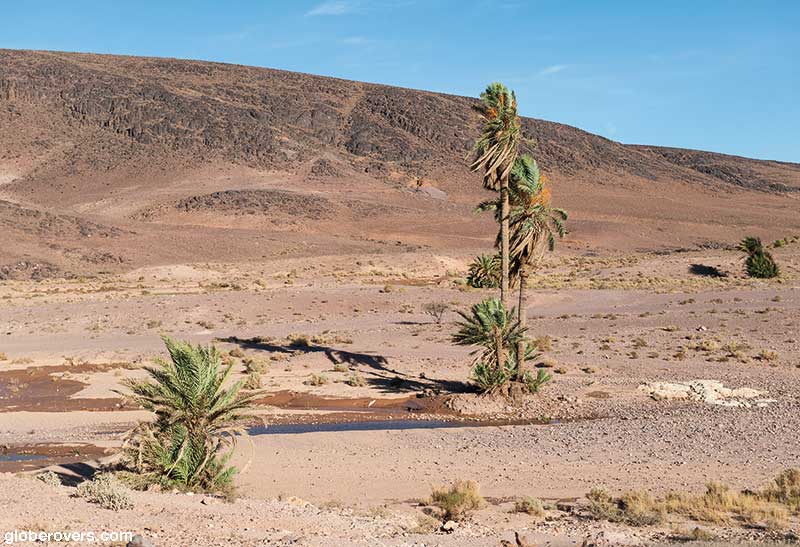
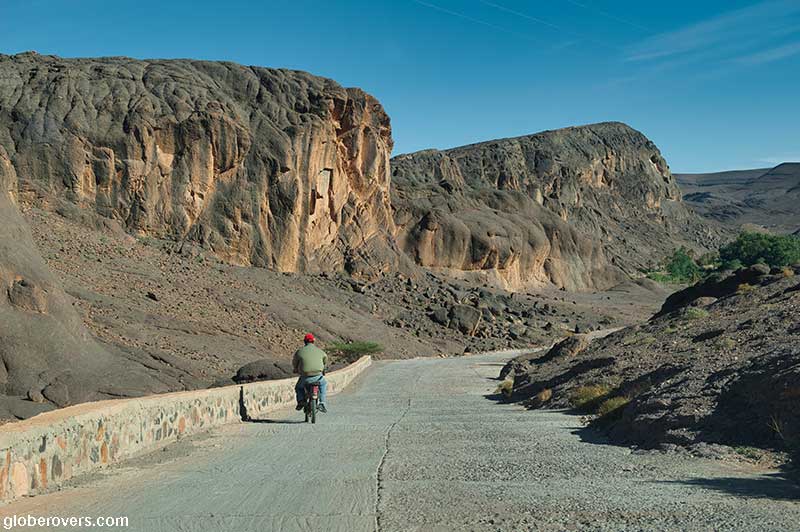
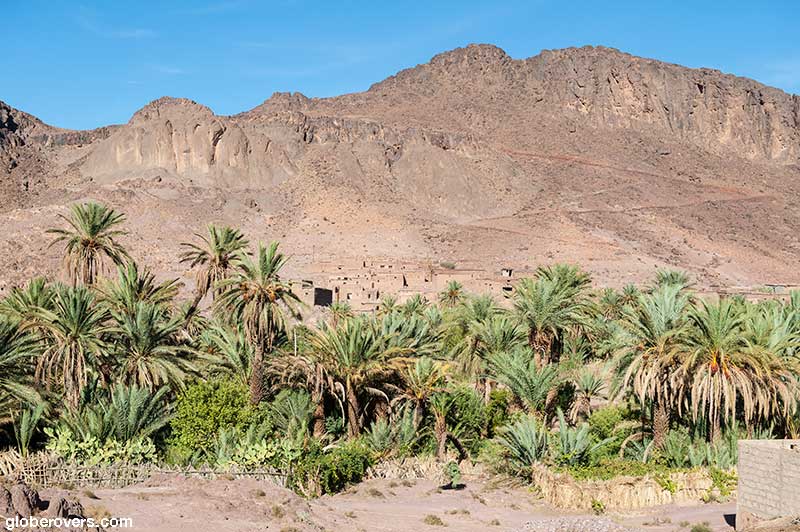
It is easy to do a day trip from Ouarzazate to Fint. However, stay overnight in one of the few guesthouses at Fint if you can and experience sunset and sunrise over the oasis. At night you may be entertained by the unique combination of Berber, Arab and African rhythms. Ask around as some local families offer homestay at a very modest fee, which includes dinner and breakfast. Morocco’s rural people have a reputation for hospitality which is legendary. You won’t be disappointed with the people at Fint Oasis.
A four-wheeler is not essential between Ouarzazate and Fint, unless the road is washed out by the rains.
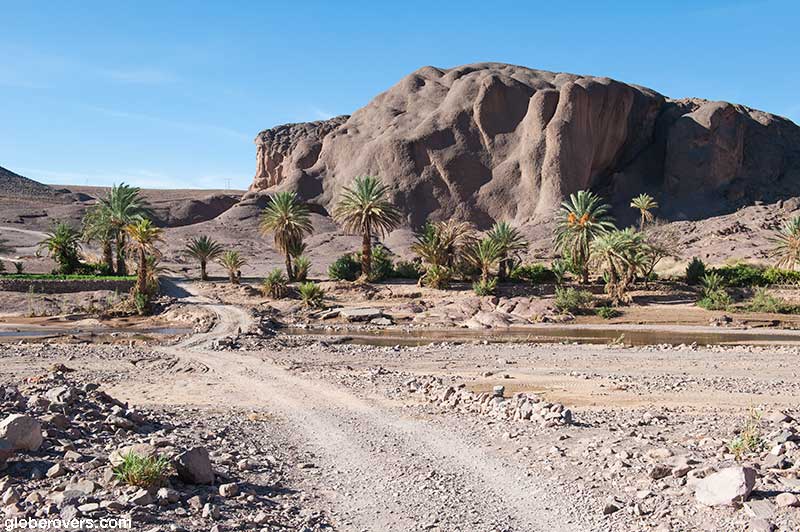
☛ Read more: 7 Unforgettable Morocco Travel Adventures
☛ Read more: The Gorges south of High Atlas Mountains
☛ Read more: Atlantic Coast: Essaouira to El Jadida
☛ Read more: 9 Great Travel Experiences in Morocco

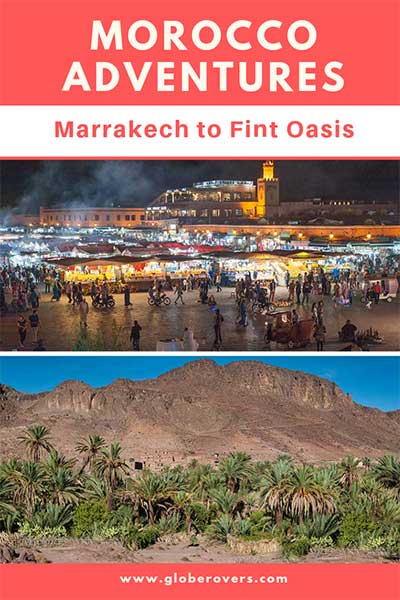
Further reading
- Coming soon

Blog post and photos by Peter who has been travelling almost full-time since 2005 and has been to over 122 countries. He visited several countries, such as Japan, more than 20 times. Peter is Editor-in-Chief and Publisher of GlobeRovers Magazine, an independent travel magazine focused on intrepid destinations.

